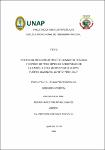Potencial bio-combustible de la madera tostada y carbón de tres especies maderables de la parcela 2 del arboretum el huayo, Puerto Almendra, Loreto-Perú, 2017
Abstract
In the present study the potential yield of bio-fuel products was quantified toasted wood and standing charcoal from E. grandiflora, C. cateniformis and V. obovata from the plot 2 of the Arboretum "El Huayo" in Puerto Almendra. The samples for the calculation of the potential yield of the standing trees were made by means of a forest census from the 25 cm diameter of the DBH of the species E. grandifolia, C. cateniformis and V. obovata of plot 2 of the arboretum "El Huayo"; and with allometric formulae the tree volume was determined and with data obtained in the laboratory for yields in toasted wood and coal of these species, the potential yield in kilograms was calculated. The results show that the highest bio-fuel yield in toasted wood was in E. grandiflora with 2 011,3 kg/tree, followed by C. cateniformis with 1 072,3 kg/tree, while V. obovata is the one with the lowest yield 435,8 kg/tree. Coal was 1 070,4 kg/tree, 504,6 kg/tree and 200,9 kg/tree respectively. While the highest potential yield in roasted wood per hectare was determined in E. grandifolia with 54 304,0 kg/ha and in coal with 28 900,5 kg/ha. Se cuantificó el rendimiento potencial de los productos bio-combustibles madera tostada y carbón de árboles en pie de Eschweilera grandiflora (Aubl.) Sandwith, Cedrelinga cateniformis (Ducke) y Virola obovata (Ducke) de la parcela 2 del Arboretum “El Huayo” del CIEFOR Puerto Almendra. Las muestras para el cálculo del rendimiento potencial se colectaron mediante un censo forestal a partir de los 25 cm de DAP de las especies E. grandifolia, C. cateniformis y V. obovata y con fórmulas alométricas se determinó el volumen arbóreo y con datos obtenidos en el laboratorio de Química de la Madera de la Facultad de Ciencias Forestales para rendimientos en madera tostada y carbón de estas especies, se calculó el rendimiento potencial en kilogramos. Los resultados muestran que el más alto rendimiento potencial de bio-combustible se obtuvo en la madera tostada de la E. grandiflora con 2011,3 kg/árbol, seguido de C. cateniformis con 1072,3 kg/árbol, mientras que V. obovata presenta el menor rendimiento 435,8 kg/árbol. Con respecto al carbón el rendimiento potencial fue de 1070,4 kg/árbol, 504,6 kg/árbol y 200,9 kg/árbol, respectivamente. E. grandifolia obtuvo el más alto rendimiento potencial de 54 304,0 Kg/ha en madera tostada y 28 900,5 kg/ha en carbón.
Collections
- Tesis [524]


